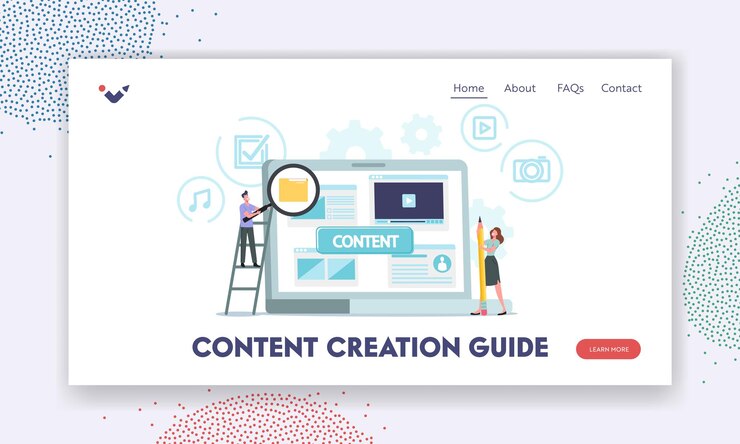B2B content marketing is a way of creating and sharing content that attracts and engages other businesses. It helps you to build your brand, generate leads, and increase sales. B2B content marketing can take many forms, such as blog posts, white papers, case studies, videos, webinars, and podcasts. The key is to provide valuable information that solves the problems or meets the goals of your target audience. For example, if you sell accounting software, you might create content that helps small businesses manage their finances, taxes, and invoices. B2B content marketing is different from B2C content marketing, which focuses on consumers’ personal interests. B2B content marketing requires a deeper understanding of your audience’s needs, challenges, and decision-making process. You also need to choose the right channels and formats to reach them effectively. For more information, you can check out these resources: [B2B Content Marketing: The Ultimate Guide] [B2B Content Marketing: What It Is & How to Do It] [B2B Content Marketing: Your Guide to Content Marketing for B2B] we hope this helps you to learn more about B2B content marketing.
What are some examples of B2B content marketing?
Some examples of B2B content marketing are:
– **Case studies**: These are stories that showcase how a company solved a problem or achieved a goal using a product or service. They usually include the challenge, the solution, and the results. Case studies can help to demonstrate the value and benefits of a product or service, as well as build trust and credibility with potential customers. For example, Zapier, a platform that connects different apps and automates workflows, uses listicles to present its case studies in an engaging and easy-to-read way.
– **Original research**: This is content that provides new data, insights, or findings that are relevant to a specific industry or topic. Original research can help to establish thought leadership, generate leads, and attract media attention. For example, Aira, a digital marketing agency, conducted a survey on the state of link building in 2021 and published a report that revealed the trends, challenges, and best practices of this SEO strategy. Another example is Lily Ray, an SEO director, who analyzed the characteristics of top-performing content on Google Discover, a personalized feed of articles and videos.
– **E-books**: These are long-form content that provides in-depth information or guidance on a specific topic. E-books can help to educate and inform potential customers, as well as capture their contact information in exchange for downloading the content. For example, HubSpot, a software company that offers tools for marketing, sales, and customer service, produces e-books on various topics such as social media, email marketing, and lead generation.
A B2B content marketing strategy
A B2B content marketing strategy is a plan that helps you create and distribute content that attracts and engages other businesses. It can help you achieve various goals, such as increasing brand awareness, generating leads, and boosting sales. To create a B2B content marketing strategy, you can follow these steps:
– Define your goal. What do you want to achieve with your content marketing? For example, do you want to increase traffic to your website, generate more qualified leads, or improve customer retention? Your goal should be specific, measurable, achievable, relevant, and time-bound (SMART).
– Identify your audience and their needs. Who are your ideal customers? What are their pain points, challenges, and goals? How do they make buying decisions? You can create buyer personas to represent your target audience and segment them based on different criteria, such as industry, company size, role, and stage in the buyer’s journey.
– Conduct a content audit. What content do you already have? How well is it performing? What gaps and opportunities exist? You can use tools like Google Analytics, SEMrush, or HubSpot to analyze your existing content and identify what works and what doesn’t. You can also benchmark your content against your competitors and see how you can differentiate yourself.
– Choose a content management system. How will you create, store, and manage your content? You need a platform that allows you to plan, produce, publish, and measure your content effectively. You can use tools like WordPress, Drupal, or Contentful to create and manage your content. You can also use tools like CoSchedule, Airtable, or Trello to organize and schedule your content.
– Determine which type of content you want to create. What format and style of content will best suit your audience and your goal? You can choose from various types of content, such as blog posts, white papers, case studies, videos, webinars, podcasts, infographics, and more. You should also consider the tone and voice of your content and how it reflects your brand personality and values.
– Brainstorm content ideas. What topics and keywords will you cover in your content? You can use tools like AnswerThePublic, BuzzSumo, or Ahrefs to find out what your audience is searching for, what questions they have, and what content is popular and trending. You can also use tools like Portent’s Content Idea Generator, HubSpot’s Blog Ideas Generator, or Quora to generate content ideas based on your keywords.
– Publish and manage your content. When and where will you publish and distribute your content? You need a content calendar that outlines the title, format, deadline, and channel of each piece of content. You also need a content distribution strategy that leverages various channels, such as your website, email, social media, and paid ads, to reach and engage your audience.
– Measure and optimize your content. How will you track and evaluate the performance and impact of your content? You need to define key performance indicators (KPIs) that align with your goal and measure how well your content is achieving it. You can use tools like Google Analytics, SEMrush, or HubSpot to monitor and analyze your content metrics, such as traffic, conversions, leads, and sales. You can also use tools like Hotjar, Crazy Egg, or UserTesting to get feedback and insights from your audience and optimize your content accordingly.
These are the basic steps to create a B2B content marketing strategy. You can find more information and examples in these resources: [How to Create a B2B Content Strategy] [Crafting a Winning B2B Content Marketing Strategy: A 7-Step Guide] [How to Develop a Content Strategy in 7 Steps: A Start-to-Finish Guide] [B2B Content Marketing Strategy: 8 Steps to Create an Effective Strategy] [Content Marketing Strategy for B2B: Best Tactics + Examples]
How to measure the ROI of B2B content marketing?
Measuring the ROI of your B2B content marketing is important to understand the effectiveness and impact of your content strategy. It can help you optimize your budget, improve your content quality, and achieve your business goals. However, measuring ROI can be challenging, especially in the B2B space, where the sales cycle is longer and more complex, and the attribution is harder to track.
There are different ways to measure the ROI of your B2B content marketing, depending on your objectives, channels, and metrics. Here are some common methods and formulas that you can use:
– The primary way to calculate your B2B content marketing ROI is to use this formula: ROI = (gains from investment – cost of investment)/ (cost of investment) × 100%³. This formula compares the revenue generated by your content marketing activities to the total cost of producing and distributing them. For example, if you spend $10,000 on creating and promoting a white paper, and the white paper generates $50,000 in sales, your ROI would be ($50,000 – $10,000) / ($10,000) x 100% = 400%. This means that for every dollar you invested in the white paper, you earned four dollars in return.
– Another way to calculate your B2B content marketing ROI is to use the customer lifetime value (CLV) and customer acquisition cost (CAC) metrics. CLV is the total revenue that a customer generates for your business over their entire relationship with you. CAC is the total cost of acquiring a new customer, including the cost of your content marketing efforts. To calculate the ROI using these metrics, you can use this formula: ROI = (CLV – CAC) / CAC x 100%. For example, if your average CLV is $5,000 and your average CAC is $1,000, your ROI would be ($5,000 – $1,000) / ($1,000) x 100% = 400%. This means that for every dollar you spend on acquiring a new customer, you earn four dollars in return.
– A third way to calculate your B2B content marketing ROI is to use the return on ad spend (ROAS) metric. ROAS is the revenue generated by your paid advertising campaigns divided by the cost of those campaigns. It is similar to ROI, but it only focuses on the paid channels, such as Google Ads, Facebook Ads, or LinkedIn Ads. To calculate the ROAS, you can use this formula: ROAS = revenue/cost. For example, if you spend $1,000 on a Google Ads campaign, and the campaign generates $4,000 in sales, your ROAS would be $4,000 / $1,000 = 4. This means that for every dollar you spent on the Google Ads campaign, you earned four dollars in return.
These are some of the ways to measure the ROI of your B2B content marketing.
However, you should also consider other factors, such as the quality of your leads, the length of your sales cycle, the attribution model you use, and the intangible benefits of your content, such as brand awareness, trust, and loyalty. You can use tools like Google Analytics, SEMrush, or HubSpot to track and analyze your content performance and ROI. You can also check out these resources for more information and examples: [Ultimate Guide to Measuring B2B Marketing ROI] [How to Calculate Your B2B Marketing ROI (the Easy Way)] [5 metrics to measure your B2B content marketing ROI]
Do not hesitate to ask us about solving problems in B2B Content Marketing services. We may be the decisive step in your life. Contact us now, or follow up on our social media



